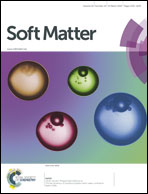Dynamic wetting model for the isotropic-to-nematic transition over a flat substrate
Abstract
Phase ordering over solid substrates is a ubiquitous and important soft material transformation process whose description incorporates wetting, anchoring and phase transition kinetics. In this paper the kinetics of the isotropic-to-nematic isothermal phase transition over a flat solid surface in a growing spherical drop is analyzed based on the Landau–de Gennes Q-tensor order parameter equations. The model, based on a previously derived interface force balance and a newly derived contact line force balance, is shown to be consistent with the generic model of conservative interface and contact line motions. The advancing dynamic contact angle equation is extracted from kinematic compatibility between the moving isotropic–nematic interface and contact line. A tractable surface phase transition kinetic model obtained by focusing on the dominant phase transition and wetting driving forces yields: (i) the constant advancing dynamic contact angle θ, and (ii) the contact line speed as a function of undercooling ΔT. It is shown that as undercooling increases, the surface phase transition mode approaches the bulk phase transition mode, such that θ approaches π. The elastic and wetting parameters that control the phase transformation process are identified and experiments for their determination are defined. These dynamic wetting and surface phase transition results significantly expand existing characterization methods of LC-substrate interfaces based on static phase transition droplet methods.


 Please wait while we load your content...
Please wait while we load your content...